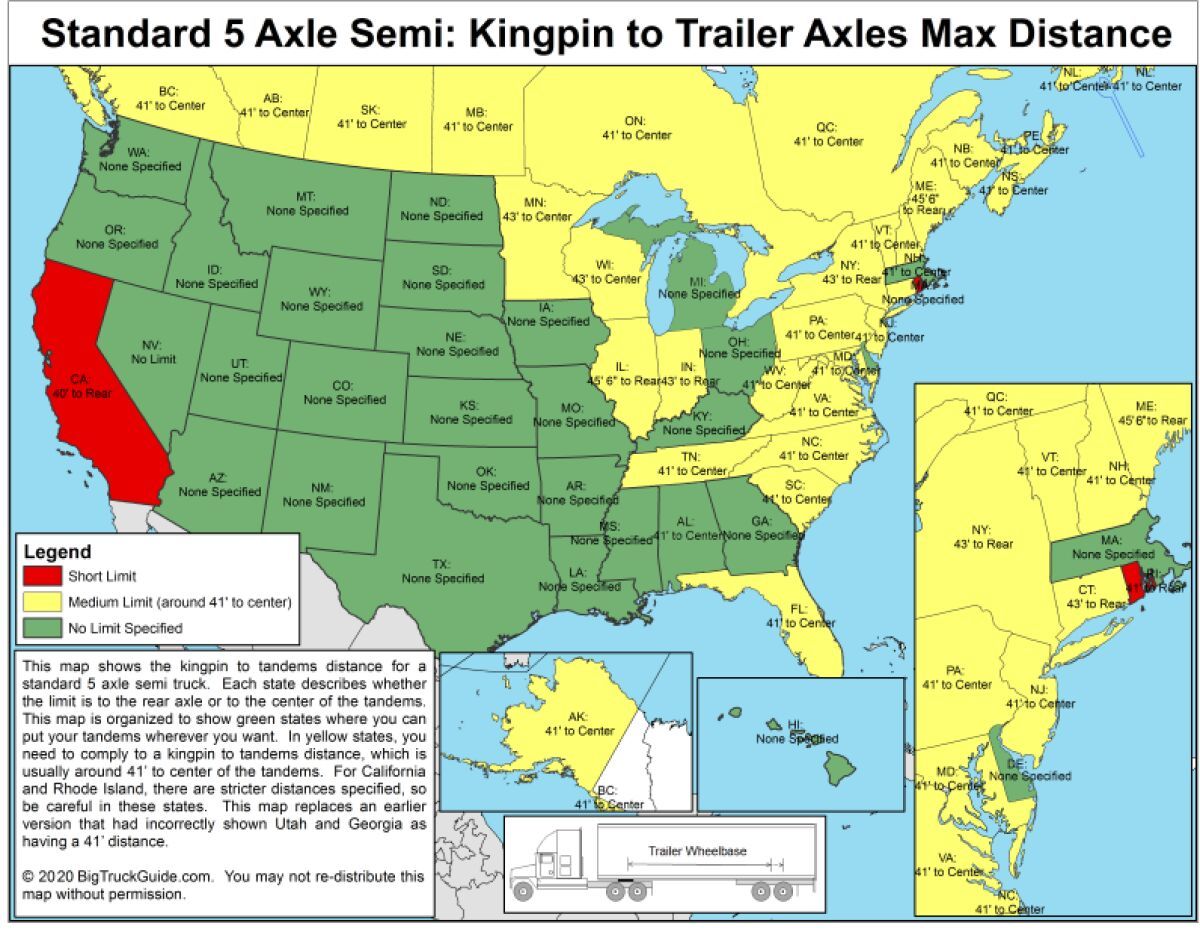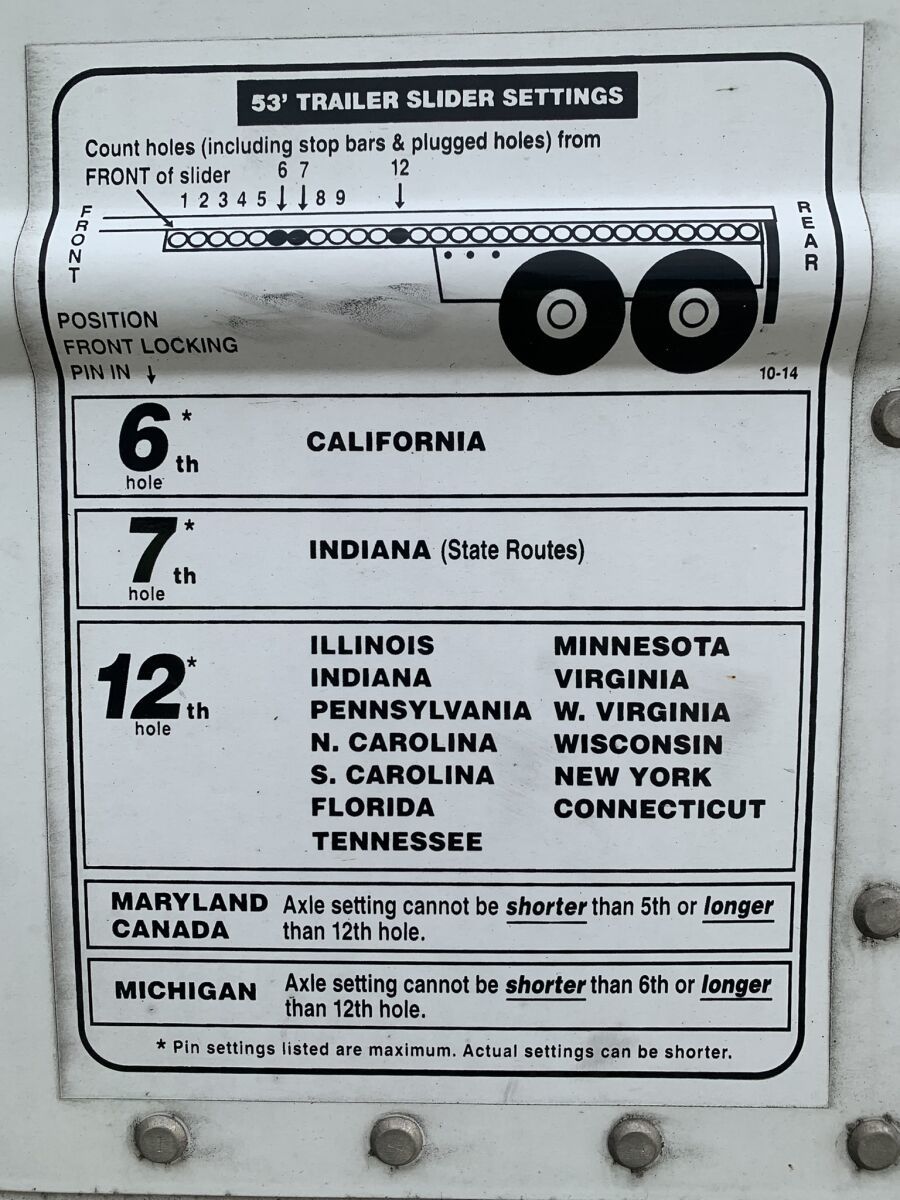Tandem Position And Turning Radius
Topic 32912 | Page 1
Good point, BK.
Another big thing to consider is how it affects backing up. You have two big things to consider:
1) The trailer will rotate more quickly with the tandems further forward and more slowly with the tandems further back, so you have to time your wheel inputs differently.
2) You have a lot of tail swing with the tandems slid forward and much less tail swing with the tandems further back. It is not uncommon to find backing situations that are much easier to manage with the tandems slid back because you won't have to manage the tail swing. Doing a sharp 90-degree back into a narrow spot is an excellent example.
Tandems:
Tandem Axles
A set of axles spaced close together, legally defined as more than 40 and less than 96 inches apart by the USDOT. Drivers tend to refer to the tandem axles on their trailer as just "tandems". You might hear a driver say, "I'm 400 pounds overweight on my tandems", referring to his trailer tandems, not his tractor tandems. Tractor tandems are generally just referred to as "drives" which is short for "drive axles".
Tandem:
Tandem Axles
A set of axles spaced close together, legally defined as more than 40 and less than 96 inches apart by the USDOT. Drivers tend to refer to the tandem axles on their trailer as just "tandems". You might hear a driver say, "I'm 400 pounds overweight on my tandems", referring to his trailer tandems, not his tractor tandems. Tractor tandems are generally just referred to as "drives" which is short for "drive axles".
I guess you wouldn't have been able to get away with that in most Eastern states or some Midwest states either, since sliding the tandems all the way back would exceed the legal length between kingpin and tandems.
Here's a guide to legal lengths by state in case anyone needs it for quick reference.
I picked up a load from Ikea last week that forced me to slide the tandems back to the 41' limit for NJ, MA, and VA. I ended up with over 33,000+ on the tandems and 29,000+ on the drives.

Tandems:
Tandem Axles
A set of axles spaced close together, legally defined as more than 40 and less than 96 inches apart by the USDOT. Drivers tend to refer to the tandem axles on their trailer as just "tandems". You might hear a driver say, "I'm 400 pounds overweight on my tandems", referring to his trailer tandems, not his tractor tandems. Tractor tandems are generally just referred to as "drives" which is short for "drive axles".
Tandem:
Tandem Axles
A set of axles spaced close together, legally defined as more than 40 and less than 96 inches apart by the USDOT. Drivers tend to refer to the tandem axles on their trailer as just "tandems". You might hear a driver say, "I'm 400 pounds overweight on my tandems", referring to his trailer tandems, not his tractor tandems. Tractor tandems are generally just referred to as "drives" which is short for "drive axles".
This sticker is on all Prime trailers to remind us which states have king pin distance restrictions. It is set up by the maximum number of holes allowed back from the front.

Yeah, all valid points about tandem position. Thanks Brett for including the backing/tail swing considerations.
Wow, so many things to learn and take into consideration.
Tandem:
Tandem Axles
A set of axles spaced close together, legally defined as more than 40 and less than 96 inches apart by the USDOT. Drivers tend to refer to the tandem axles on their trailer as just "tandems". You might hear a driver say, "I'm 400 pounds overweight on my tandems", referring to his trailer tandems, not his tractor tandems. Tractor tandems are generally just referred to as "drives" which is short for "drive axles".
I guess you wouldn't have been able to get away with that in most Eastern states or some Midwest states either, since sliding the tandems all the way back would exceed the legal length between kingpin and tandems.
Here's a guide to legal lengths by state in case anyone needs it for quick reference.
I picked up a load from Ikea last week that forced me to slide the tandems back to the 41' limit for NJ, MA, and VA. I ended up with over 33,000+ on the tandems and 29,000+ on the drives.
I use that chart all the time to make sure I'm within the legal limits. I've also been heavier on the tandems than the drives being as far back as I could be. Being new I was worried I was doing something wrong. Glad to read it from an experienced driver, so thanks for sharing, RealDiehl.
Tandems:
Tandem Axles
A set of axles spaced close together, legally defined as more than 40 and less than 96 inches apart by the USDOT. Drivers tend to refer to the tandem axles on their trailer as just "tandems". You might hear a driver say, "I'm 400 pounds overweight on my tandems", referring to his trailer tandems, not his tractor tandems. Tractor tandems are generally just referred to as "drives" which is short for "drive axles".
Tandem:
Tandem Axles
A set of axles spaced close together, legally defined as more than 40 and less than 96 inches apart by the USDOT. Drivers tend to refer to the tandem axles on their trailer as just "tandems". You might hear a driver say, "I'm 400 pounds overweight on my tandems", referring to his trailer tandems, not his tractor tandems. Tractor tandems are generally just referred to as "drives" which is short for "drive axles".
At some customers that are tight and I have concerns about tail swing I'll move mine all the way back for the exact reasons Brett stated. Particularly a few GP plants that have only 90 access with very limited room.
I've also found it to be far more forgiving as it takes it longer to adjust. I can make more precise movements. Other customers where I need it to pivot sooner or need to make sharper turns forward and tail swing or off tracking isn't as much a concern I'll put them forward.
I also practiced a lot backing with them in different positions.
New Reply:
New! Check out our help videos for a better understanding of our forum features

















Preview:








 TT On Facebook
TT On Facebook
Something to be aware of is the relationship between the position of the trailer tandems to the turning radius of the trailer.
My last load scaled out 9000 lbs heavier on the drives. 29,000 on drives, 38,000 on the trailer. To get legal, I ended up sliding the tandems all the way to the back. This was the first time I’ve run with my tandems all the way back. My usual loads let me be much more close to the front. I ended up with about 33,000 on both axles for the trip.
Driving with the trailer tandems all the way back makes for a greater turning radius of the trailer. It requires greater vigilance when making turns because of the increased danger of hitting something with the back of the trailer when making turns. I noticed how much extra space I needed to swing right or left. Watching the trailer in the mirrors when turning is critical.
The only advantage was when I reached my delivery. They required all drivers to slide their tandems all the way back. I already had that done.
Tandems:
Tandem Axles
A set of axles spaced close together, legally defined as more than 40 and less than 96 inches apart by the USDOT. Drivers tend to refer to the tandem axles on their trailer as just "tandems". You might hear a driver say, "I'm 400 pounds overweight on my tandems", referring to his trailer tandems, not his tractor tandems. Tractor tandems are generally just referred to as "drives" which is short for "drive axles".
Tandem:
Tandem Axles
A set of axles spaced close together, legally defined as more than 40 and less than 96 inches apart by the USDOT. Drivers tend to refer to the tandem axles on their trailer as just "tandems". You might hear a driver say, "I'm 400 pounds overweight on my tandems", referring to his trailer tandems, not his tractor tandems. Tractor tandems are generally just referred to as "drives" which is short for "drive axles".